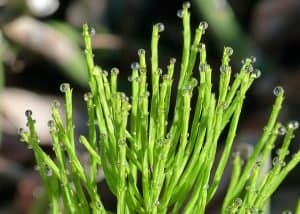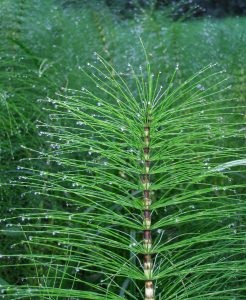What is Horsetail Plant?
Horsetail plant (Equisetum hyemale) is a non-flowering evergreen perennial, also known as a rough horse or scouring rush. It has vertical green stems with lines. The stems of this plant are thin, and it reproduces through spores (not seeds), like ferns. Horsetail also has several other names, such as the central tail, horse pipes, snake grass, and articulated grass.

Scientific Classification of the Horsetail Plant
Kingdom: Plantae
Clade: Tracheophytes
Class: Polypodiopsida
Subclass: Equisetidae
Order: Equisetales
Family: Equisetaceae
Genus: Equisetum
Types of Horsetail Plant
Great horsetail
It is a native South American plant that can grow from 2 to 5 meters tall.
Water horsetail
Also known as a horsetail swamp, the water horsetail (Equisetum fluviatile) is a slender, dark green plant with hollow and articulated stems up to 40 inches tall, which has no real flowers or leaves. The shoots have 10 to 30 longitudinal ridges and thin walls, which make them weak. Instead of flowers and fruits, water horses have structures that produce cone-like spores that appear at the ends of the fruiting stems.
Field horsetail
It is of two types of stems (sterile and fertile), which appear each year from the rhizomes. The rhizomes are fleshy and tubular, measuring up to 3/4 inches in diameter and can grow singly or in pairs at the joints. The fertile stems have no chlorophyll and die after spores have been spread. They have dark, creeping rhizomes, of brown wool and are tubular. The stems that measure up to 4 inches in length are fragile, disconnected, and have spore ends.
Scouring Rush Horsetail
The evergreen stems without dark leaves, all fertile and which do not die in autumn, distinguish the abrasive buckwheat (Equisetum hyemale) from the field horses. The stems look similar to field horsetail; they are green, however, with two black bands identical to the sections. The stem reaches up to 4 feet tall when mature and has a spore cone, called a strobilus, which appears on top in various shades of brown.

How to Grow Horsetail Plant?
The primary requirement for growing a horsetail is abundant water. It will grow in sandy or clayey soil and also in fertile potting soil. It is happy to grow in partial shade or full sun.
Horsetail is grown from nursery plants, not from seeds, although rhizome pieces can be transplanted to grow new plants.
If you can’t find horsetail in your local grocery store or farmer’s market, you can always try growing yours. Horsetail is a rustic plant and a great addition to any garden but can also be invasive. Plant it in a pot or keep an eye on it as the horsetail grows about a meter and a half and will take your garden if you leave it.
A horsetail does not breed. Instead, it grows from the rhizomes – an underground stem similar to a root. You should be able to find young plants or rhizomes in your local nursery. Plant in early spring under full or partial sunshine. A horsetail plant is native to swampy areas and prefers moist soil, high heat, and humidity. If you live in a colder climate, the aboveground part of the plant will turn brown in winter, but the rhizome will survive underground and produce new green shoots in spring.
Where can I buy the Horsetail Plant?
You can buy a horsetail plant in a local nursery and florist. You can also find a horsetail plant for sale in Amazon as well as Etsy. If you are looking to buy dried Horsetail Herb, we suggest the Amazon store is one of the best places to get your desired herb.
Uses of Horsetail Plant
The horsetail is a very precious herb with its high silicon content used in the treatment of osteoporosis. Horsetail is useful to lower blood pressure, as a diuretic, to strengthen brittle nails, stop bleeding gums, relieve sore throats, and as timely treatment of burns and wounds.
- Improving kidney and bladder health
- Promoting a healthy body weight
- Supporting healthy hair and nails
- Easing heavy periods
- Maintaining urinary tract health
- Strengthens our bones and tendons

Amelia is a plant and nature lover! Ever since she was little, she loved spending time in her family’s garden and learning about how to care for each plant individually. As an adult, she has dedicated herself to sharing what she has learned and continuing to expand her knowledge on the plant kingdom.
